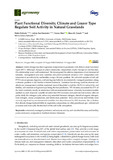Mostrar el registro sencillo del ítem
Plant functional diversity, climate and grazer type regulate soil activity in natural grasslands
| dc.creator | Debouk, Haifa | es_ES |
| dc.creator | San Emeterio Garciandía, Leticia | es_ES |
| dc.creator | Marí, Teresa | es_ES |
| dc.creator | Canals Tresserras, Rosa María | es_ES |
| dc.creator | Sebastià, M.T. | es_ES |
| dc.date.accessioned | 2021-02-02T09:41:10Z | |
| dc.date.available | 2021-02-02T09:41:10Z | |
| dc.date.issued | 2020 | |
| dc.identifier.issn | 2073-4395 (Electronic) | |
| dc.identifier.uri | https://hdl.handle.net/2454/39128 | |
| dc.description.abstract | Global change modifies vegetation composition in grasslands with shifts in plant functional types (PFT). Although changes in plant community composition imply changes in soil function, this relationship is not well understood. We investigated the relative importance of environmental (climatic, management and soil) variables and plant functional diversity (PFT composition and interactions) on soil activity and fertility along a climatic gradient. We collected samples of soil and PFT biomass (grasses, legumes, and non-legume forbs) in six extensively managed grasslands along a climatic gradient in the Northern Iberian Peninsula. Variation Partitioning Analysis showed that abiotic and management variables explained most of the global variability (96.5%) in soil activity and fertility; soil moisture and grazer type being the best predictors. PFT diversity accounted for 27% of the total variability, mostly in interaction with environmental factors. Diversity-Interaction models applied on each response variable revealed that PFT-evenness and pairwise interactions a_ected particularly the nitrogen cycle, enhancing microbial biomass nitrogen, dissolved organic nitrogen, total nitrogen, urease, phosphatase, and nitrification potential. Thus, soil activity and fertility were not only regulated by environmental variables, but also enhanced by PFT diversity. We underline that climate change-induced shifts in vegetation composition can alter greenhouse gas-related soil processes and eventually the feedback of the soil to the atmosphere. | en |
| dc.description.sponsorship | This work was funded by the Spanish Science Foundation (FECYT) through the projects CAPAS (CGL2010-22378-C03-01), BIOGEI (CGL2013-49142-C2-1-R) and IMAGINE (CGL2017-85490-R). H. Debouk was supported by a FPI fellowship from the Spanish Ministry of Economy and Competitiveness (BES-2011-047009). L. San Emeterio was funded by a Talent Recruitment grant from Obra Social La Caixa—Fundación CAN. | en |
| dc.format.extent | 20 p. | |
| dc.format.mimetype | application/pdf | en |
| dc.language.iso | eng | en |
| dc.publisher | MDPI | en |
| dc.relation.ispartof | Agronomy, 2020, 10(9), 1291 | en |
| dc.rights | © 2020 by the authors. Licensee MDPI, Basel, Switzerland. This article is an open access article distributed under the terms and conditions of the Creative Commons Attribution (CC BY) license. | en |
| dc.rights.uri | http://creativecommons.org/licenses/by/4.0/ | |
| dc.subject | Extensively managed grasslands | en |
| dc.subject | Soil enzyme activity | en |
| dc.subject | Soil microbial biomass | en |
| dc.subject | Soil fertility | en |
| dc.subject | Plant community composition | en |
| dc.subject | Northern Iberian Peninsula | en |
| dc.title | Plant functional diversity, climate and grazer type regulate soil activity in natural grasslands | en |
| dc.type | info:eu-repo/semantics/article | en |
| dc.type | Artículo / Artikulua | es |
| dc.contributor.department | Institute on Innovation and Sustainable Development in Food Chain - ISFOOD | es_ES |
| dc.rights.accessRights | info:eu-repo/semantics/openAccess | en |
| dc.rights.accessRights | Acceso abierto / Sarbide irekia | es |
| dc.identifier.doi | 10.3390/agronomy10091291 | |
| dc.relation.projectID | info:eu-repo/grantAgreement/MINECO//CGL2013-49142-C2-1-R/ES/ | en |
| dc.relation.projectID | info:eu-repo/grantAgreement/AEI/Plan Estatal de Investigación Científica y Técnica y de Innovación 2013-2016/CGL2017-85490-R/ES/ | en |
| dc.relation.publisherversion | https://doi.org/10.3390/agronomy10091291 | |
| dc.type.version | info:eu-repo/semantics/publishedVersion | en |
| dc.type.version | Versión publicada / Argitaratu den bertsioa | es |



